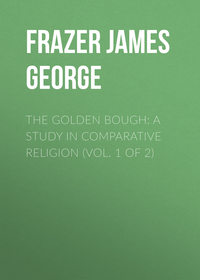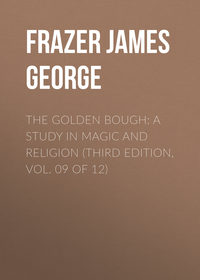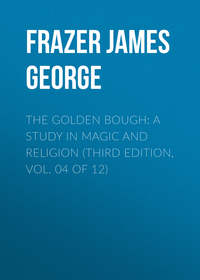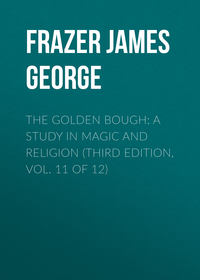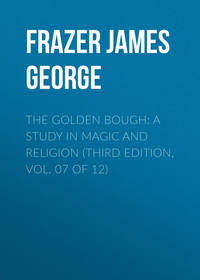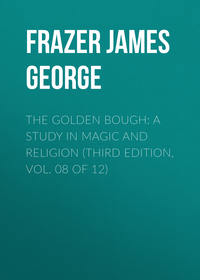
The Belief in Immortality and the Worship of the Dead, Volume 2 (of 3)
933
Krusenstern, op. cit. i. 165; Langsdorff, i. 112 sq.; Fleurieu, op. cit. i. 132-134; Porter, op. cit. ii. 64; Melville, Typee, p. 199; Vincendon-Dumoulin et C. Desgraz, op. cit. p. 225; Eyriaud des Vergnes, op. cit. pp. 24 sq.
934
Mathias G – , op. cit. 101 sq.
935
Lisiansky, op. cit. p. 80.
936
Lisiansky, op. cit. pp. 79 sq.; Clavel, op. cit. p. 62.
937
Mathias G – , op. cit. pp. 47 sq.; Vincendon-Dumoulin et C. Desgraz, op. cit. p. 259.
938
Radiguet, op. cit. p. 153.
939
Vincendon-Dumoulin et C. Desgraz, op. cit. pp. 258 sq.; Clavel, op. cit. pp. 65 sq.
940
Eyriaud des Vergnes, op. cit. pp. 35 sq. Compare Radiguet, op. cit. p. 155.
941
Langsdorff, op. cit. i. 118.
942
Krusenstern, op. cit. i. 172. In this quotation I have altered the spelling tahbu into taboo.
943
Langsdorff, op. cit. i. 116.
944
Radiguet, op. cit. p. 157; Melville, Typee, p. 230; Vincendon-Dumoulin et C. Desgraz, op. cit. p. 264.
945
Clavel, op. cit. p. 68.
946
Clavel, op. cit. pp. 67 sq.
947
Vincendon-Dumoulin et C. Desgraz, op. cit. p. 258; Mathias G – , op. cit. p. 48; Radiguet, op. cit. p. 153; Clavel, op. cit. p. 65.
948
Krusenstern, op. cit. i. 171.
949
C. S. Stewart, op. cit. i. 243 sq. Compare Vincendon-Dumoulin et C. Desgraz, op. cit. p. 240; Radiguet, op. cit. pp. 218 sq.
950
The principal harbour of Nukahiva.
951
C. S. Stewart, op cit. i. 244 sq. Compare Vincendon-Dumoulin et C. Desgraz, op. cit. pp. 226, 240 sq. The missionary William Crook was landed in the Marquesas from the missionary ship Duff in 1797. See J. Wilson, Missionary Voyage to the Southern Pacific Ocean, pp. 131 sqq.
952
Mathias G – , op. cit. p. 45.
953
Porter, op. cit. ii. 114.
954
Radiguet, op. cit. pp. 223 sq. For the names of the Marquesan deities, among whom Tiki appears to have been the most famous, and for some myths concerning them, see Mathias G – , op. cit. pp. 40 sqq.; Radiguet, op. cit. pp. 221 sqq.; Amable, in Annales de la Propagation de la Foi, xix. (1847) pp. 23 sq.; Eyriaud des Vergnes, op. cit. pp. 27 sqq.
955
C. S. Stewart, op. cit. i. 245 sq.; Vincendon-Dumoulin et C. Desgraz, op. cit. pp. 227 sq.
956
Langsdorff, op. cit. i. 136. The writer's language seems to imply that the spirit whom the priestly physician caught in his hands and interrogated was the patient's own soul.
957
Mathias G – , op. cit. p. 45; C. S. Stewart, op. cit. i. 247; Vincendon-Dumoulin et C. Desgraz, op. cit. pp. 228 sq.
958
Radiguet, op. cit. pp. 238 sq.
959
Radiguet, op. cit. p. 245; Clavel, op. cit. p. 44, note1. Compare Mathias G – , op. cit. p. 115.
960
Mathias G – , op. cit. pp. 114. sq.; Eyriaud des Vergnes, op. cit. p. 58. Compare Radiguet, op. cit. pp. 260 sqq.
961
C. S. Stewart, op. cit. i. 263; Vincendon-Dumoulin et C. Desgraz, op. cit. pp. 249 sq.
962
Radiguet, op. cit. p. 284; Clavel, op. cit. p. 39.
963
Porter, op. cit. ii. 121.
964
Radiguet, op. cit. pp. 283 sq. Another writer mentions that at the moment of death it was customary for a number of matrons to strip themselves naked and execute obscene dances at the door of the house, crying out at the pitch of their voices, "Father! father!" See Mathias G – , op. cit. p. 116.
965
Melville, Typee, pp. 180, 201.
966
Clavel, op. cit. pp. 43 sq.
967
Clavel, op. cit. p. 46.
968
Radiguet, op. cit. pp. 284 sq.
969
C. S. Stewart, op. cit. i. 265; Vincendon-Dumoulin et C. Desgraz, op. cit. p. 251.
970
Langsdorff, op. cit. i. 133.
971
Radiguet, op. cit. p. 285.
972
Krusenstern, op. cit. i. 173. Compare Langsdorff, op. cit. i. 133; C. S. Stewart, op. cit. i. 265; Vincendon-Dumoulin et C. Desgraz, op. cit. p. 251.
973
Krusenstern, op. cit. i. 172 sq.; Langsdorff, op. cit. i. 133; Lisiansky, op. cit. p. 81; C. S. Stewart, op. cit. i. 264.
974
Mathias G – , op. cit. pp. 116 sq. As to the decoration of the corpse, see Clavel, op. cit. pp. 43 sq. As to the temporary house or shed in which the body was kept for some time after death, compare C. S. Stewart, op. cit. i. 264, 266; Vincendon-Dumoulin et C. Desgraz, op. cit. p. 250. As for the custom of keeping the body for months in the ordinary house, surrounded by the family, see Radiguet, op. cit. p. 286. As to the practice of hanging food beside the body, even after its removal to its last place of rest, see J. Dumont d'Urville, Voyage au Pole Sud et dans l'Océanie, Histoire du Voyage, iv. (Paris, 1842), p. 33; Clavel, op. cit. p. 46.
975
Krusenstern, op. cit. i. 173; Langsdorff, op. cit. i. 133 sq.; Melville, Typee, p. 206; Radiguet, op. cit. pp. 286 sq.; Clavel, op. cit. pp. 44 sq. In a house in Nukahiva the missionary Stewart saw a canoe-shaped coffin containing the remains of a man who had died many years before. It was raised on a bier of framework, at a height of two or three feet above the ground. Stewart adds, "The dead bodies of all persons of high distinction are preserved in their houses for a long period in this way." See C. S. Stewart, op. cit. i. 259.
976
Clavel, op. cit. pp. 45 sq.; Baessler, op. cit. pp. 233 sq.
977
Krusenstern, op. cit. i. 127, 173; Langsdorff, op. cit. i. 115, 134. Other writers on the Marquesas in like manner speak of a morai simply as a place of burial. See Porter, op. cit. ii. 114 ("the gods at the burying-place, or morai, for so it is called by them"); Radiguet, op. cit. p. 52 ("un morai (sépulchre) en ruine"); Melville, Typee, p. 168 ("the 'morais' or burying-grounds"). So, too, the term was understood by the French navigator, J. Dumont d'Urville. See his Voyage au Pole Sud, Histoire du Voyage, iv. (Paris, 1842), pp. 27, 33.
978
Vincendon-Dumoulin et C. Desgraz, op. cit. p. 253.
979
Langsdorff, op. cit. i. 115. According to Krusenstern (op. cit. i. 127), the morais in general "lie a good way inland upon hills."
980
F. D. Bennett, Narrative of a Whaling Voyage, i. 329.
981
Langsdorff, op. cit. i. 115.
982
Vincendon-Dumoulin et C. Desgraz, op. cit. p. 253.
983
Radiguet, op. cit. p. 92. One of these stones was said to have been erected by the French navigator, Captain Marchand, and to have formerly borne an inscription recording his taking possession of the island. Hence it would be unsafe to draw any conclusion from the supposed antiquity of these two tall upright stones.
984
C. S. Stewart, op. cit. i. 260.
985
F. D. Bennett, op. cit. i. 329.
986
Compare J. Dumont d'Urville, Voyage au Pole Sud, Histoire du Voyage, iv. 33, "Sous un hangar se trouvent quelques supports formant, à 2 mètres au-dessus du sol, une estrade sur laquelle est déposé le toui-papao. C'est le nom que les naturels donnent au cadavre enveloppé d'herbes et de tapa (étoffes de papyrus faites dans le pays). On n'aperçoit du corps ainsi habillé que les extremités des doigts des pièds et des mains."
987
F. D. Bennett, op. cit. i. 331.
988
F. D. Bennett, op. cit. i. 322.
989
Melville, Typee, pp. 166 sq.
990
Melville, Typee, p. 167.
991
Quoted by J. Wilson, Missionary Voyage to the Southern Pacific Ocean, p. 144.
992
Melville, Typee, p. 205.
993
Porter, op. cit. ii. 123.
994
Krusenstern, op. cit. i. 173.
995
Langsdorff, op. cit. i. 134.
996
Melville, Typee, p. 206.
997
Clavel, op. cit. p. 47.
998
Mathias G – , op. cit. pp. 117 sq.
999
Krusenstern, op. cit. i. 173.
1000
Mathias G – , op. cit. p. 44.
1001
Radiguet, op. cit. p. 220; Melville, Typee, p. 185. Compare Mathias G – , op. cit. p. 40.
1002
Radiguet, op. cit. pp. 220 sq.
1003
Porter, op. cit. ii. 51 sq.; Radiguet, op. cit. pp. 238 note, 239, 269, 270; Vincendon-Dumoulin et C. Desgraz, op. cit. pp. 238 sq.; Mathias G – , op. cit. pp. 234 sq.
1004
Porter, op. cit. ii. 113.
1005
Porter, op. cit. ii. 109-111. A similar, or the same, effigy of a dead chief seated in his canoe was seen by Melville in the same valley (Typee, pp. 183 sq.). He says that "the canoe was about seven feet in length; of a rich, dark-coloured wood, handsomely carved, and adorned in many places with variegated bindings of stained sinnate [cinnet], into which were ingeniously wrought a number of sparkling sea-shells, and a belt of the same shells ran all round it. The body of the figure – of whatever material it might have been made – was effectually concealed in a heavy robe of brown tappa [bark-cloth], revealing only the hands and head; the latter skilfully carved in wood, and surmounted by a superb arch of plumes."
1006
Radiguet, op. cit. p. 163.
1007
Vincendon-Dumoulin et C. Desgraz, op. cit. p. 228.
1008
Krusenstern, op. cit. i, 170.
1009
U. Lisiansky, Voyage round the World, pp. 81 sq.
1010
Mathias G – , op. cit. p. 116.
1011
Lettre du R. P. Amable, in Annales de la Propagation de la Foi, xix. (1847) pp. 22 sq., 24.
1012
Lettre du R. P. Amable, op. cit. p. 24.
1013
Lettre du R. P. Amable, op. cit. pp. 23 sq.
1014
Lettre du R. P. Amable, op. cit. p. 24.
1015
Lisiansky, op. cit. p. 89.
1016
Radiguet, op. cit. pp. 161 sq.
1017
Mathias G – , op. cit. p. 40.
1018
Mathias G – , op. cit. p. 210.
1019
Radiguet, op. cit. pp. 224 sq.
1020
Radiguet, op. cit. pp. 227, 240.
1021
Eyriaud des Vergnes, op. cit. pp. 31 sq.
1022
Baessler, op. cit. p. 234.
1023
Baessler, op. cit. pp. 193 sq.
1024
Radiguet, op. cit. pp. 227-238.
1025
J. Cook, Voyages, iii. 274-281; compare G. Forster, Voyage round the World (London, 1777), ii. 5 sqq.
1026
C. P. Claret Fleurieu, Voyage round the World performed during the years 1790, 1791, and 1792 by Étienne Marchand (London, 1801), i. 31, 51. Marchand's brief account is supplemented from other sources by his editor Fleurieu (op. cit. i. 55 sqq.).
1027
A. J. von Krusenstern, Voyage round the World in the years 1803, 1804, 1805, and 1806 (London, 1813), i. 108 sq., 133 sqq.; U. Lisiansky, Voyage round the World (London, 1814), pp. 62, 95; G. H. von Langsdorff, Bemerkungen auf einer Reise um die Welt in den Jahren 1803 bis 1807 (Frankfurt am Main, 1812), i. 75, 161.
1028
Krusenstern, op. cit. i. 110-112; Lisiansky, op. cit. p. 79; Langsdorff, op. cit. i. 77, 83-85. As to the subsequent history of Roberts and Cabri, see Vincendon-Dumoulin et C. Desgraz, Iles Marquises ou Nouka-hiva (Paris, 1843), pp. 356-359.
1029
Captain David Porter, Journal of a Cruise made to the Pacific Ocean in the United States frigate Essex in the years 1812, 1813, and 1814, Second Edition (New York, 1822), ii. 5, 141.
1030
D. Porter, op. cit. ii. 17 sq.
1031
C. S. Stewart, Visit to the South Seas (London, 1832), i. pp. x sq., 193, 331. The writer speaks (p. 331) of his stay of "a fortnight at the Washington Islands." Mr. Crook first landed in the island of Santa Christina (Tau-ata) on June 6th, 1797. See James Wilson, Missionary Voyage to the Southern Pacific Ocean (London, 1799), pp. 129 sqq. As to his subsequent history in the islands, see Vincendon-Dumoulin et C. Desgraz, Iles Marquises ou Nouka-hiva, pp. 35-40.
1032
F. D. Bennett, Narrative of a Whaling Voyage round the Globe from the year 1833 to 1836 (London, 1840), i 296, 346.
1033
Le P. Mathias G – , Lettres sur les Iles Marquises (Paris, 1843). The writer is not explicit as to the dates of his residence in the Marquesas; but he tells us that he spent two years in habitual intercourse with the natives (p. 49), and from other allusions which he makes in his narrative (pp. 28 sq.) it would seem that the years were 1839 and 1840. The first Catholic missionaries landed in 1838 (ib. p. 22), and others in 1839 (ib. pp. 23 sq.). Among the latter were Fathers Garcia and Guilmard (ib. p. 24). Father G – may have been one of them.
1034
H. Melville, Typee (London, Everyman's Library), p. 254.
1035
Vincendon-Dumoulin et C. Desgraz, op. cit. pp. 119 sqq.
1036
Vincendon-Dumoulin et C. Desgraz, Iles Marquises ou Nouka-hiva (Paris, 1843).
1037
J. Dumont d'Urville, Voyage au Pole Sud et dans l'Océanie, Histoire du Voyage, iv. (Paris, 1842), pp. 5, 49.
1038
Max Radiguet, Les Derniers Sauvages, Nouvelle Édition (Paris, 1882). The author does not inform us as to the exact length of his stay in the islands.
1039
M. Radiguet, op. cit. p. 221 note.
1040
P. E. Eyriaud des Vergnes, L'Archipel des Iles Marquises (Paris, 1877).
1041
Some years previously a naval lieutenant, M. Jouan, who had been in command of the French military post at Nukahiva, published in the Revue Coloniale (1857-1858) some notes on the Marquesas, which are said to contain some useful information on the archipelago. See M. Radiguet, op. cit. p. 310 note. I have not seen the work of M. Jouan; but according to Radiguet it shows that in the twelve years and more which had elapsed since the French occupation of the islands the presence of French missionaries and of a French garrison had done little to civilise the natives.
1042
Les Marquisiens, par M. le Docteur Clavel (Paris, 1885).
1043
Clavel, op. cit. pp. 68-71.
1044
Arthur Baessler, Neue Südsee-Bilder (Berlin, 1900), pp. 189-242. The writer omits to mention the date of his visit to the islands, and the length of his stay in them.
1045
W. Ellis, Polynesian Researches, iv. 4 sqq.; J. J. Jarves, History of the Hawaiian or Sandwich Islands (London, 1843), pp. 1 sqq.; J. Remy, Histoire de l'Archipel Havaiien (Paris and Leipzig, 1862), pp. vii sqq.; C. E. Meinicke, Die Inseln des Stillen Oceans, ii. 271 sqq.; Encyclopaedia Britannica, Ninth Edition, xi. 528 sqq.; A. Marcuse, Die Hawaiischen Inseln (Berlin, 1894), pp. 1 sqq.; F. H. H. Guillemard, Australasia, ii. 533 sqq.
1046
J. Cook, Voyages, vii. 94; W. Ellis, Polynesian Researches, iv. 34, 379; C. S. Stewart, Residence in the Sandwich Islands, Fifth Edition (Boston, 1839), pp. 69 sqq., 140; D. Tyerman and G. Bennet, Journal of Voyages and Travels, i. 366, 391; Ch. Wilkes, United States Exploring Expedition, New Edition (New York, 1851), iii. 373.
1047
W. Ellis, op. cit. iv. 13 sq.; C. S. Stewart, op. cit. pp. 213 sqq., 229 sqq.; Tyerman and Bennet, op. cit. i. 426 sqq.; J. Remy, op. cit. pp. xiv sq.; Ch. Wilkes, op. cit. iii. 390 sq.; F. D. Bennett, Narrative of a Whaling Voyage round the Globe (London, 1840), i. 198 sqq. The vale of Anuanu, which runs up into the mountains from the plain of Honululu in the island of Oahu, is especially famed for its natural beauty.
1048
J. Remy, op. cit. pp. xvi sqq. Compare J. Cook, Voyages, vii. 99 sq.; W. Ellis, op. cit. iv. 21 sq.; Ch. Wilkes, op. cit. iv. 283 sq.; J. J. Jarves, op. cit. pp. 12 sqq.; Encyclopaedia Britannica, 9th edition, xi. 530.
1049
C. S. Stewart, Residence in the Sandwich Islands, p. 104.
1050
J. Cook, Voyages, vii. 112 sq., 115 sq.; U. Lisiansky, Voyage round the World, pp. 123 sq.; L. de Freycinet, Voyage autour du Monde, Historique, ii. Deuxième partie (Paris, 1839), p. 570; W. Ellis, op. cit. iv. 23; C. S. Stewart, Residence in the Sandwich Islands, pp. 104, 106; J. J. Jarves, op. cit. pp. 77 sqq.; J. Remy, op. cit. pp. xxxvii sq.; F. D. Bennett, op. cit. i. 209. The last of these writers speaks in unfavourable terms of the personal appearance of the women, whom he found less handsome than the men and very inferior to the women of the Society Islands.
1051
J. Cook, Voyages, vi. 213 sq., vii. 121; W. Ellis, op. cit. iv. 23.
1052
J. Cook, Voyages, vi. 215 sq., 219, 224 sq., vii. 126 sq.; U. Lisiansky, Voyage round the World, p. 126; Archibald Campbell, Voyage round the World (Edinburgh, 1816), pp. 161-63, 182 sq., 194-197; W. Ellis, op. cit. iv. 61, 215 sq., 420 (as to irrigation); C. S. Stewart, Residence in the Sandwich Islands, pp. 111-113; Tyerman and Bennet, op. cit. i. 412, 426, 428, 430, 472; O. von Kotzebue, Neue Reise um die Welt (Weimar, 1830), ii. 96; J. J. Jarves, op. cit. pp. 68 sq.; J. Remy, op. cit. pp. xxiv sq., xliii; F. D. Bennett, Narrative of a Whaling Voyage round the World, i. 213 sqq. As to the system of irrigating the taro fields, see especially O. von Kotzebue, Voyage of Discovery into the South Sea and Beering's Straits (London, 1821), i. 340 sq.
1053
J. Cook, Voyages, vii. 113 sq.
1054
J. Cook, vii. 125.
1055
J. Cook, Voyages, vi. 214 sq.; U. Lisiansky, Voyage round the World, p. 127; A. Campbell, Voyage round the World, pp. 180-182; C. S. Stewart, Residence in the Sandwich Islands, p. 107; W. Ellis, op. cit. iv. 320-322; Tyerman and Bennet, op. cit. i. 371 sq.; J. J. Jarves, op. cit. pp. 67 sq.
1056
J. Cook, Voyages, vi. 218 sq., vii. 133-135; L. de Freycinet, Voyage autour du Monde, Historique, ii. 611 sq.; A. Campbell, Voyage round the World, pp. 192-195; W. Ellis, op. cit. iv. 109-113; C. S. Stewart, Residence in the Sandwich Islands, pp. 114-116; J. J. Jarves, op. cit. pp. 66 sq.
1057
J. Cook, Voyages, vi. 220-224; A. Campbell, op. cit. p. 198; W. Ellis, op. cit. iv. 322; O. von Kotzebue, Neue Reise um die Welt, ii. 97 (as to the kava bowls); J. J. Jarves, op. cit. p. 66. As to the absence of mines in the Hawaiian Islands, see J. Remy, op. cit. p. xvi.
1058
J. Cook, Voyages, vi. 227 sq., vii. 136 sq.; W. Ellis, op. cit. iv. 156 sq.; J. J. Jarves, op. cit. pp. 56 sq.
1059
U. Lisiansky, op. cit. pp. 116 sq.; A. Campbell, op. cit. pp. 169 sq.; W. Ellis, op. cit. iv. 411 sq.; C. S. Stewart, Residence in the Sandwich Islands, p. 102; Tyerman and Bennet, op. cit. i. 380; J. J. Jarves, op. cit. pp. 30 sqq. According to Jarves (op. cit. p. 33), "Rank was hereditary, and descended chiefly from the females, who frequently held the reins of government in their own right. This custom originated in the great license existing between the sexes; no child, with certainty, being able to designate his father, while no mistake could be made in regard to the mother."
1060
C. S. Stewart, Residence in the Sandwich Islands, p. 101; J. J. Jarves, op. cit. p. 30; J. Remy, op. cit. pp. lxi sq.; Encyclopædia Britannica, 9th Edition, xi. 528.
1061
C. S. Stewart, op. cit. p. 97; W. Ellis, op. cit. iv. 412 sq., 414; J. J. Jarves, op. cit. p. 33. Compare J. Cook, Voyages, vii. 137 sqq.


